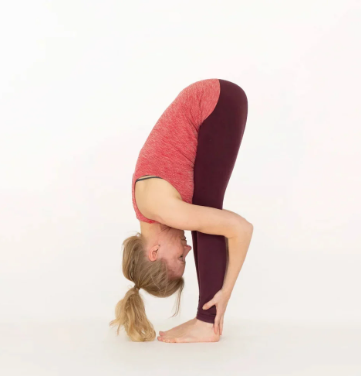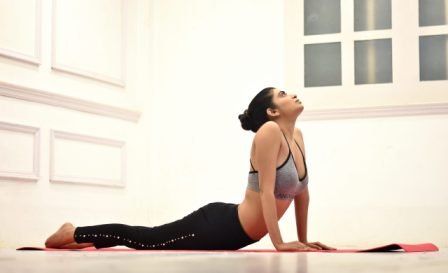Do you feel that your body is stiff most of the time? Are you struggling with movements? Well, flexibility is something which cannot be built overnight and you will need to make some effort on your part. Now, when we talk about a natural approach, then you must opt for yoga for flexibility.
How Does Yoga Improve Flexibility?
- When you perform yoga, then you will stretch various muscle groups. The stretches help in strengthening and elongating the muscles
- The stretches activate your muscles and they tend to become flexible over the passage of time
- When you perform yoga poses for flexibility, then your body will develop more awareness about different sensations. The benefit is that you will be able to utilize your flexible muscles in the best way
Best Yoga Poses for Flexibility:
Forward Fold:
The stretch helps to stretch the lower back, calves and hamstrings. As a result, you can look forward to flexibility in the legs and spine.

Steps of Forward Fold:
- You need to stand up and your feet should be hip-width apart. It is essential that you engage your quadriceps and lift the kneecaps. The core muscles also need to be engaged. You must draw the navel towards the spine.
- Start inhaling and make sure that you lift the arms overhead. You must lengthen the spine by lifting through the crown of your head
- When you are exhaling, then try hinging at the hips. Start bending forward from your waist. Lead with the chest as you start folding forward. Try bringing the torso towards the thighs
- Make sure that you allow the hands to come down to the floor on either side of the feet. Try bending the knees for easing the stretch
- The head must hang heavy and try relaxing the neck completely. It is important that you hold the pose for at least 30 seconds
Downward Facing Dog:
Well, the best thing about this pose is that it helps to stretch the entire body. It also helps in strengthening your legs and arms.

Steps of Downward Facing Dog:
- First you must bring your body into the table pose and the wrists must be aligned under the shoulders. It is essential that the knees must be under the hips
- Your fingers must be wide apart and the fingers must point forward. You should try pressing into your palms. The weight must be distributed across the hands
- Try tucking your toes under and make sure that you lift your hips. Make sure that you lift the hips towards the ceiling. Make sure that you straighten the arms and the legs so that you can create an inverted V-shape with the body
- You must engage the quadriceps also for lifting the knees off the floor. There should be a slight bend in the knees to maintain the length in the spine
- Start pressing the heels down towards the floor. Lengthen the spine and lift the sitting bones towards the ceiling
- The head must be between the upper arms.
- Try drawing the shoulder blades down the back. You must maintain a steady breath and hold the pose for at least 30 seconds.
Cobra Pose:
What is worth mentioning about this pose is that it helps in strengthening the spine, shoulders and chest.

Steps of Cobra Pose:
- For the cobra pose, you must start by lying on the stomach. It is vital that the legs must be extended behind you.
- The hands must be underneath the shoulders. The elbows must be tucked close to the sides. It is vital that the fingertips must point forward.
- Engage the core muscles by drawing the navel towards the spine. The benefit is that your lower back will get the needed support
- When you are inhaling try lifting the chest by making use of the strength of your back muscles. The elbows must be close to the body
- Continue lifting the chest while you lengthen your spine. Make sure that you press firmly into the hands when you are lifting your torso
- Try rolling your shoulders back and down. Ensure that your gaze is directed upwards. Expand your chest with each inhale and lower the back with each exhale. You must hold the cobra pose for at least 15 to 30 seconds
Pigeon Pose:
The pose helps in stretching the hip flexor. It also helps in to increase the flexibility in the groin and the hips.

Steps of Pigeon Pose:
- You must begin in a tabletop position on the hands and the knees. The wrist must be aligned under the shoulders. The knees must be under the hips
- Try lifting the hips and the back so that you can come into the Downward Facing dog pose
- Start exhaling and try to bring the right knee towards the right wrist. The right knee must be placed on the mat near the right wrist
- Start sliding the left leg behind you and make sure that you straighten it as much as you can. The left hip must be squared towards the mat front. The left knee must be bent and your foot must be pointed
- The right foot must be flexed. The right shin must be parallel with the front edge of the mat. The hips must be at level with the pelvis
- Start lowering your body towards the mat. The benefit is that you will feel a deep stretch in the thighs and your right hip. Make sure that you keep your hands on the mat so that you can get the support you want. Try holding the pigeon pose for about 5 to 10 breaths
Benefits of Yoga for Flexibility:
- When you do yoga for flexibility, then you will witness improved blood circulation. Plus, your muscles will get all the necessary nutrients
- Yoga reduces stress and promotes improved flexibility
- The good news is that flexible muscles tends to make you less prone to injuries
Importance of Flexibility:
When you talk about the importance of flexibility, then it helps in maintaining functional independence. When you have flexible muscles, then it becomes easy for you to move around. Flexibility exercises are incorporated in injury rehabilitation programs also because they help you recover fast.
Why Should We Focus on Flexibility?
You should focus on flexibility because it helps to maintain your posture. The muscles can easily maintain their natural length when you are flexibility. When you have a good body posture, it refines your personality more.
Incorporating Yoga for Flexibility into a Routine:
When you plan to incorporate Yoga in your routine, then it is essential that you must have realistic goals. Always warmup your body when you start your Yoga routine. Target specific areas when you perform Yoga. The benefit is that you will be in a position to get the best results.
Conclusion:
You will notice that when you do Yoga for flexibility, then you can build improved mind body connection. When you start to practice, then what is essential is that you must practice yoga on a regular basis. The benefit is that you will be in a position to get the best results. Take the first step and you will enjoy the routine by all means for sure. Your fitness will be worth it at the end of the day.

